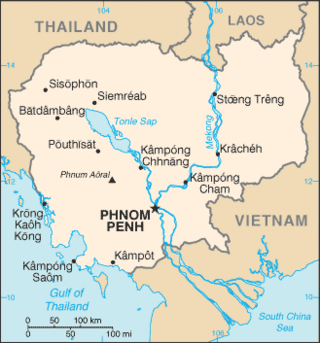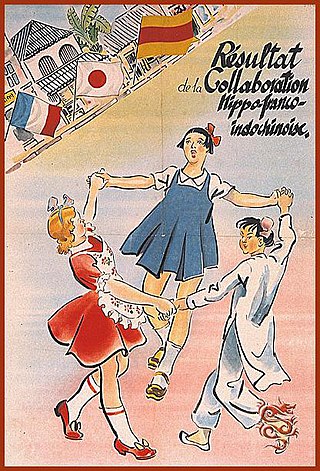
The People's Army of Vietnam (PAVN), officially the Vietnam People's Army, also recognized as the Vietnamese Army or the People's Army, is the national military force of the Socialist Republic of Vietnam and the armed wing of the ruling Communist Party of Vietnam (CPV). The PAVN is a part of the Vietnam People's Armed Forces and includes: Ground Force, Navy, Air Force, Border Guard and Coast Guard. Vietnam does not have a separate Ground Force or Army service. All ground troops, army corps, military districts and special forces belong to the Ministry of National Defence, directly under the command of the CPV Central Military Commission, the Minister of National Defence, and the General Staff of the Vietnam People's Army. The military flag of the PAVN is the National flag of the Socialist Republic of Vietnam defaced with the motto Quyết thắng added in yellow at the top left.

The Vietnam War was a conflict in Vietnam, Laos, and Cambodia from 1 November 1955 to the fall of Saigon on 30 April 1975. It was the second of the Indochina Wars and was a major conflict of the Cold War. While the war was officially fought between North Vietnam and South Vietnam, the north was supported by the Soviet Union, China, and other communist states, while the south was supported by the United States and other anti-communist allies, making the war a proxy war between the United States and the Soviet Union. It lasted almost 20 years, with direct U.S. military involvement ending in 1973. The conflict also spilled over into neighboring states, exacerbating the Laotian Civil War and the Cambodian Civil War, which ended with all three countries officially becoming communist states by 1976.

South Vietnam, officially the Republic of Vietnam was a country in Southeast Asia that existed from 1955 to 1975, the period when the southern portion of Vietnam was a member of the Western Bloc during part of the Cold War after the 1954 division of Vietnam. It first received international recognition in 1949 as the State of Vietnam within the French Union, with its capital at Saigon, before becoming a republic in 1955. South Vietnam was bordered by North Vietnam to the north, Laos to the northwest, Cambodia to the southwest, and Thailand across the Gulf of Thailand to the southwest. Its sovereignty was recognized by the United States and 87 other nations, though it failed to gain admission into the United Nations as a result of a Soviet veto in 1957. It was succeeded by the Republic of South Vietnam in 1975. In 1976, the Republic of South Vietnam and North Vietnam merged to form the Socialist Republic of Vietnam.

Võ Nguyên Giáp was a militarily self-taught general of the People's Army of Vietnam (PAVN), communist revolutionary and politician. Regarded as one of the greatest military strategists of the 20th century, Giáp commanded Vietnamese communist forces in various wars. He served as the military commander of the Việt Minh and later the PAVN from 1941 to 1972, as the minister of defence of the Democratic Republic of Vietnam and later Socialist Republic of Vietnam in 1946–1947 and from 1948 to 1980, and as deputy prime minister from 1955 to 1991. He was also a member of the Politburo of the Communist Party of Vietnam.

The Việt Minh was a national independence coalition formed at Pác Bó by Hồ Chí Minh on 19 May 1941. Also known as the Việt Minh Front, it was created by the Indochinese Communist Party (ICP) as a national united front to achieve the independence of the Democratic Republic of Vietnam.

The Pathet Lao, officially the Lao People's Liberation Army, was a communist political movement and organization in Laos, formed in the mid-20th century. The group ultimately conquered the entire country in 1975, after the Laotian Civil War. The Pathet Lao were always closely associated with Vietnamese communists and North Vietnam. During the civil war, it was effectively organized, equipped and even led by the People's Army of Vietnam (PAVN). They fought against the anti-communist forces in the Vietnam War. Eventually, the term became the generic name for Laotian communists. Under orders from Mao Zedong, the People's Liberation Army provided 115,000 guns, 920,000 grenades and 170 million bullets, and trained more than 700 of its military officers.

The Laotian Civil War (1959–1975) was a civil war in Laos waged between the Communist Pathet Lao and the Royal Lao Government from 23 May 1959 to 2 December 1975. It is associated with the Cambodian Civil War and the Vietnam War, with both sides receiving heavy external support in a proxy war between the global Cold War superpowers. It is known as the Secret War among the American CIA Special Activities Center, and Hmong and Mien veterans of the conflict.

The Cambodian Civil War was a civil war in Cambodia fought between the forces of the Communist Party of Kampuchea against the government forces of the Kingdom of Cambodia and, after October 1970, the Khmer Republic, which had succeeded the kingdom.

The Sino-Vietnamese War was a brief conflict that occurred in early 1979 between China and Vietnam. China launched an offensive in response to Vietnam's invasion and occupation of Cambodia in 1978, which ended the rule of the Chinese-backed Khmer Rouge. The conflict lasted for about a month, with China withdrawing its troops in March 1979.

The Third Indochina War was a series of interconnected armed conflicts, mainly among the various communist factions over strategic influence in Indochina after Communist victory in South Vietnam, Laos, and Cambodia in 1975. The conflict primarily started due to continued raids and incursions by the Khmer Rouge into Vietnamese territory that they sought to retake. These incursions would result in the Cambodian–Vietnamese War in which the newly unified Vietnam overthrew the Pol Pot regime and the Khmer Rouge, in turn ending the Cambodian genocide. Vietnam had installed a government led by many opponents of Pol Pot, most notably Hun Sen, a former Khmer Rouge commander. This led to Vietnam's occupation of Cambodia for over a decade. The Vietnamese push to completely destroy the Khmer Rouge led to them conducting border raids in Thailand against those who had provided sanctuary.

The Geneva Conference was a conference that was intended to settle outstanding issues resulting from the Korean War and the First Indochina War and involved several nations. It took place in Geneva, Switzerland, from 26 April to 20 July 1954. The part of the conference on the Korean question ended without adopting any declarations or proposals and so is generally considered less relevant. On the other hand, the Geneva Accords that dealt with the dismantling of French Indochina proved to have long-lasting repercussions. The crumbling of the French colonial empire in Southeast Asia led to the formation of the states of the Democratic Republic of Vietnam, the State of Vietnam, the Kingdom of Cambodia, and the Kingdom of Laos. Three agreements about French Indochina, covering Cambodia, Laos, and Vietnam, were signed on 21 July 1954 and took effect two days later.

The Cambodian–Vietnamese War was an armed conflict between Democratic Kampuchea, controlled by Pol Pot's Khmer Rouge, and the Socialist Republic of Vietnam. The war began with repeated attacks by the Liberation Army of Kampuchea on the southwestern border of Vietnam, particularly the Ba Chúc massacre which resulted in the deaths of over 3,000 Vietnamese civilians. On 23 December 1978, 10 out of 19 divisions of Khmer Rouge's military divisions opened fire along the shared Southwestern borderline with Vietnam with the goal of invading the Vietnamese provinces of Đồng Tháp, An Giang and Kiên Giang. On 25 December 1978, Vietnam launched a full-scale invasion of Kampuchea, and subsequently occupied the country in 2 weeks and removed the government of the Communist Party of Kampuchea from power. In doing so, Vietnam put an ultimate stop to the Cambodian Genocide, during which 25% of the Cambodian population had already been executed under Pol Pot’s regime.

Army and warfare made their first appearance in Vietnamese history during the 3rd millennium BC. Throughout thousands of years, wars played a great role in shaping the identity and culture of people inhabited the land which is modern day Vietnam. Vietnam is regarded as one of the most militaristic countries in Southeast Asia, there is even a higher level belief Vietnam might be the most militaristic nation in Southeast Asia, and one of Asia and the world's most militaristic countries. The military history of today’s Socialist Republic of Vietnam began when Japan invaded French Indochina, they defeated the French resistance after nearly a hundred years of oppression and inspired many countries worldwide to take up the fight against foreign invaders. Since then, Vietnam has fought in many conflicts.

The Khmer Issarak was a "loosely structured" anti-French and anti-colonial independence movement. The movement has been labelled as “amorphous”. The Issarak was formed around 1945 and composed of several factions, each with its own leader. Most of the Issarak factions fought actively between the end of the Second World War in 1945 and Cambodia’s independence in 1953. The initial objective of the Khmer Issarak was to fight against the French in order to gain independence, before later focusing on overthrowing the Cambodian government. The term Issarak originally referred to non-communist, but in the early 1950s the Việt Minh-guided guerrillas branded themselves Issaraks for the sake of unifying other non-communist forces.

The Sihanouk Trail was a logistical supply system in Cambodia used by the People's Army of Vietnam (PAVN) and its Viet Cong (VC) guerillas during the Vietnam War (1960–1975). Between 1966 and 1970, this system operated in the same manner and served the same purposes as the much better known Ho Chi Minh trail which ran through the southeastern portion of the Kingdom of Laos. The name is of American derivation, since the North Vietnamese considered the system integral to the supply route mentioned above. U.S. attempts to interdict this system began in 1969.
United States involvement in the Vietnam War began shortly after the end of World War II in Asia, first in an extremely limited capacity and escalating over a period of 20 years. The U.S. military presence peaked in April 1969, with 543,000 American combat troops stationed in Vietnam. By the conclusion of the United States's involvement in 1973, over 3.1 million Americans had been stationed in Vietnam.
The earliest traces of armed conflict in the territory that constitutes modern Cambodia date to the Iron Age settlement of Phum Snay in north-western Cambodia.

North Vietnam, officially the Democratic Republic of Vietnam, was a socialist state in Southeast Asia that existed from 1945 to 1976, with formal sovereignty being fully recognized in 1954. A member of the Eastern Bloc, it opposed the French-backed State of Vietnam and later the Western-allied Republic of Vietnam. North Vietnam emerged victorious over South Vietnam in 1975 and ceased to exist the following year when it unified with the south to become the current Socialist Republic of Vietnam.

In mid-1940, Nazi Germany rapidly defeated the French Third Republic, and the colonial administration of French Indochina passed to the French State. Many concessions were granted to the Empire of Japan, such as the use of ports, airfields, and railroads. Japanese troops first entered parts of Indochina in September 1940, and by July 1941 Japan had extended its control over the whole of French Indochina. The United States, concerned by Japanese expansion, started putting embargoes on exports of steel and oil to Japan from July 1940. The desire to escape these embargoes and to become self-sufficient in resources ultimately contributed to Japan's decision to attack on December 7, 1941, the British Empire and simultaneously the USA. This led to the USA declaring war against Japan on December 8, 1941. The US then joined the side of the British Empire, at war with Germany since 1939, and its existing allies in the fight against the Axis powers.


















